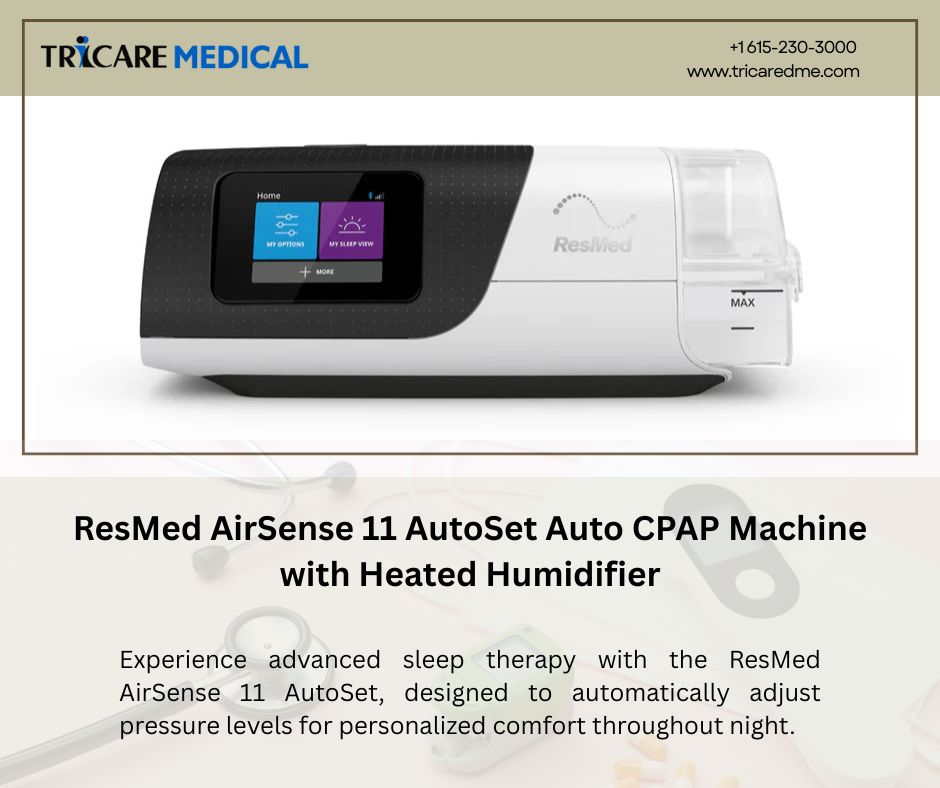How to Properly Maintain and Clean Your ResMed AirSense CPAP Machine
- 7 min reading time
Proper maintenance and cleaning of your ResMed AirSense CPAP machine are crucial to ensure it continues to operate efficiently and to maximize the benefits of your sleep therapy. Whether you're using the ResMed AirMini AutoSet Travel CPAP Machine or the ResMed AirSense 10 CPAP Machine, following a consistent cleaning routine will not only extend the lifespan of your device but also ensure optimal performance. This guide will walk you through the steps to properly maintain and clean your ResMed CPAP machine, using keywords related to different models to ensure comprehensive coverage.

Why Maintenance and Cleaning Are Essential
Regular maintenance and cleaning of your CPAP machine are vital for several reasons:
Health and Hygiene: A CPAP machine that isn’t cleaned regularly can become a breeding ground for bacteria, mold, and other pathogens. This can lead to respiratory infections and other health issues.
Efficiency: Accumulated debris and dust can clog filters and other components, reducing the machine's efficiency and effectiveness.
Longevity: Proper care can extend the life of your CPAP machine, reducing the need for costly repairs or replacements.
Daily Maintenance: Keeping Your CPAP Machine in Top Shape
For daily maintenance, follow these simple steps:
Disconnect and Inspect: Unplug your CPAP machine and disconnect the mask, tubing, and humidifier (if applicable). Check these components for any signs of wear and tear.
Wipe Down the Mask: Using a damp cloth, gently wipe down the mask to remove any facial oils or debris that may have accumulated during the night. For users of the ResMed AirFit F40 Full Face CPAP Mask with Headgear, ensure that you clean the headgear and cushion regularly to maintain comfort and effectiveness.
Check the Water Chamber: If you're using a CPAP machine with a humidifier, like the ResMed AirSense 10 Elite CPAP with HumidAir Humidifier, empty the water chamber daily and let it air dry. This prevents the buildup of minerals and bacteria.
Weekly Cleaning: A Deeper Clean for Your CPAP Machine
Once a week, perform a more thorough cleaning of your CPAP machine:
Disassemble the Components: Carefully disassemble your CPAP machine, including the mask, tubing, water chamber, and humidifier (if applicable).
Soak in Warm Soapy Water: Submerge the mask, tubing, and water chamber in a basin filled with warm, soapy water. Use a mild, fragrance-free soap to avoid irritation. Let them soak for about 30 minutes.
Rinse Thoroughly: After soaking, rinse all components under running water to remove any soap residue. Pay special attention to the tubing, ensuring no soap remains inside.
Air Dry: Place the components on a clean, dry towel and allow them to air dry completely before reassembling. Avoid direct sunlight, as it can damage the materials.
Wipe Down the Machine: Use a damp cloth to wipe down the exterior of your CPAP machine. For the ResMed AirMini AutoSet Travel CPAP Machine, ensure that all parts are completely dry before reassembly, as it’s designed for portability and compact storage.
Monthly Maintenance: Keeping Your CPAP Machine in Optimal Condition
Every month, take additional steps to maintain your CPAP machine:
Check the Filters: The filters in your CPAP machine play a crucial role in keeping dust and allergens out of the air you breathe. For users of the ResMed AirSense 10 CPAP Machine, check the filters regularly and replace them if they appear dirty or clogged. A clean filter ensures that your machine runs efficiently and that you’re breathing clean air.
Inspect the Hose for Wear: Over time, the hose connecting your mask to the machine may show signs of wear, such as cracks or holes. If you notice any damage, replace the hose immediately to maintain optimal airflow.
Replace Mask Cushions: The cushions on your CPAP mask, such as the Cushions for AirFit F40 Full Face CPAP Masks by ResMed, can degrade over time, affecting the seal and comfort. Replace them as needed to ensure a proper fit and effective therapy.
Check the Humidifier: If your CPAP machine has a humidifier, like the ResMed AirSense 10 Elite CPAP Machine with HumidAir Humidifier, inspect the water chamber for any signs of wear or mineral buildup. Replace the chamber if necessary.
Best Practices for CPAP Cleaning and Maintenance
To get the most out of your CPAP machine, consider these best practices:
Use Distilled Water: Always use distilled water in your CPAP humidifier to prevent mineral buildup and extend the life of the water chamber. This is especially important for the ResMed AirSense 10 CPAP Machine.
Avoid Harsh Chemicals: When cleaning your CPAP machine, avoid using harsh chemicals like bleach or alcohol, as they can damage the components and leave harmful residues.
Consider a CPAP Cleaning Machine: For a more thorough clean, you might consider using a CPAP cleaning machine. The best CPAP cleaning machine for ResMed AirSense 10 will sanitize your device using ozone or UV light, eliminating bacteria and viruses more effectively than manual cleaning.
Store Properly: When not in use, store your CPAP machine in a clean, dry place. For travelers using the ResMed AirMini AutoSet Travel CPAP Machine, ensure the device is stored in its protective case to prevent damage.
Common Mistakes to Avoid
While maintaining your CPAP machine, it’s important to avoid these common mistakes:
Neglecting Regular Cleaning: Skipping daily or weekly cleaning can lead to a buildup of bacteria, mold, and allergens, which can compromise your health.
Using Tap Water in the Humidifier: Tap water can contain minerals that build up in the humidifier chamber, leading to damage and reduced efficiency. Always use distilled water.
Ignoring Filter Changes: Dirty or clogged filters reduce airflow and can cause your CPAP machine to work harder, leading to potential damage.
Reassembling Wet Parts: Ensure all parts are completely dry before reassembling your CPAP machine. Moisture can lead to mold growth and damage to electronic components.
Troubleshooting Common Issues
Even with proper maintenance, you may encounter some common issues with your CPAP machine:
Reduced Airflow: If you notice reduced airflow, check the hose and filters for blockages or damage. Replacing these components may resolve the issue.
Unpleasant Odors: If your CPAP machine emits an unpleasant odor, it may be due to accumulated bacteria or mold. Perform a deep clean of all components and consider using a CPAP cleaning machine.
Mask Leaks: If your mask isn’t sealing properly, check the cushions and headgear for wear. Replacing these parts, such as the Headgear with Magnetic Clips for AirFit F40 Full Face CPAP Masks by ResMed, can restore the seal and improve comfort.

Conclusion
Proper maintenance and cleaning of your ResMed AirSense CPAP machine are essential for ensuring the longevity of your device and the effectiveness of your sleep therapy. Whether you’re using the ResMed AirMini AutoSet Travel CPAP Machine or the ResMed AirSense 10 Elite CPAP with HumidAir Humidifier, following these guidelines will help you maintain a clean, efficient, and reliable CPAP machine. By committing to a regular cleaning routine, you can breathe easy, knowing your CPAP therapy is as effective and comfortable as possible.



